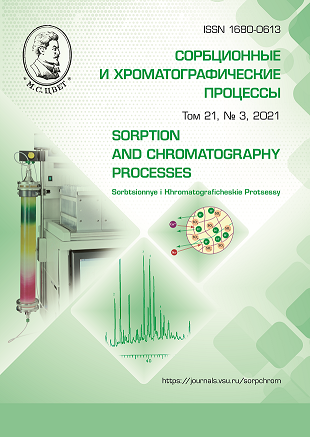Разработка методики адсорбционной иммобилизации трипсина на ионообменных смолах
Аннотация
Трипсин (КФ 3.4.21.4) является наиболее популярным ферментом в промышленности и биомедицине. Однако невозможность повторного использования и сложность восстановления делают его масштабное промышленное применение неэффективным и дорогостоящим. Решить эту проблему можно с помощью иммобилизации трипсина на ионообменных материалах. Целью работы было исследование закономерностей адсорбционной иммобилизации трипсина на ионообменных смолах для создание гетерогенного препарата на его основе, доступного для использования в отечественных лабораториях и промышленности.
Предложена методика иммобилизации трипсина на разных типах ионообменных смол: катионных смолах с функциональными группами –SO3H (КУ-2, КУ-2-8чС, IMAC-HP111), анионных смолах с активными группами –N+(CH3)3 (АВ-17-2П, Purolite A100), вторичными и третичными алифатическими аминогруппами и пиридиновыми группами (АВ-16-ГС), вторичными, третичными и четвертичными алифатическими аминогруппами (ЭДЭ-10-П). Подготовку к работе ионообменных смол и сорбционную иммобилизацию трипсина осуществляли по стандартным методикам. Измерение содержания белка в иммобилизованных препаратах трипсина проводили по модифицированному методу Лоури, протеазную активность образцов определяли на субстрате азоказеине, а эстеразную активностъ – на субстрате N-α-бензоил-DL-аргинин-n-нитроанилиде (BAPNA).
Полученные препараты трипсина, иммобилизованного на ионообменных смолах, могут стать основой для решения ряда проблем, возникающих при создании сорбентов для очистки сточных вод, при разделении и очистке различных веществ в химической промышленности, а также изучении потоков питательных веществ и внесении удобрений на полях.
Установлено, что оптимальное соотношение содержания белка (мг на г носителя), общей протеазной активности (ед на мл раствора) и удельной протеазной активности (ед на мг белка) наблюдается при иммобилизации трипсина на носителе ЭДЭ-10-П с фосфатным буфером, рН 11.0 и NaOH-KCl буфером, рН 12.0. Оптимальное соотношение содержания белка, общей эстеразной активности и удельной эстеразной активности получено при адсорбции трипсина на АВ-16-ГС с NaOH-KCl буфером, рН 12.0.
Скачивания
Литература
Milyutin V.V., Kharitonov O.V., Firsova L.A., Nekrasova N.N., Kozlitin E.A., Jour-nal of Radioanalytical and Nuclear Chemis-try, 2020, Vol. 325, pp. 667-671. DOI: 10.1007/s10967-020-07277-4.
Holyavka M.G., Kondratyev M.S., Lukin A.N., Agapov B.L. et al., International Journal of Biological Macromolecules, 2019, Vol. 138, pp. 681-692. DOI: 10.1016/j.ijbiomac.2019.07.132.
Brutskus T.K. Ionites. Catalog. Cher-kassy, 1975, 36 p.
Bachernikova S.G., Mikhalkova A.I., Esenkova N.P., Leikin Yu.A. et al., Ecologi-cal systems and devices, 2005, Vol. 3, pp. 51-52.
Holyavka M.G., Kondratyev M.S., Ter-entyev V.V., Samchenko A.A. et al., Bio-physics, 2017, Vol. 62, No 1, pp. 9-16.
Qian P., Schoenau J.J., Canadian Jour-nal of Soil Science. 2002, Vol. 82, No 1, рр. 9-21. DOI:10.4141/S00-091.
Polyansky N.G., Gorbunov N.V., Poly-anskaya N.L., Methods of research of ion exchangers, M., Chemistry, 1976, 208 p.
Gorbunov N.V., Polyansky N.G., Jour-nal of Physical Chemistry, 1978, Vol. 52, No 5, pp. 1259-1262.
Kartsova L.A., Markova O.V., Journal of Analytical Chemistry, 2000, Vol. 55, No 7, pp. 653-656.
DOI: 10.1007/BF02828000
Hassan M.M., Carr C.M., Chemo-sphere, 2018, Vol. 209, pp. 201-219.
DOI: 10.1016/j.chemosphere.2018.06.043.
Leikin Yu.A. Sorptsionnye I khroma-tograficheskie protsessy, 2004, Vol. 4, No 5 ,pp. 606-624.
Levchuk I., Rueda Márquez J.J., Sil-lanpää M., Chemosphere, 2018, Vol. 192, pp. 90-104. DOI: 10.1016/j.chemosphere.2017.10.101.
Cherepkova Yu.A., Kotova D.L., Selemenev V.F., Krysanova T.A. et al., Journal of Physical Chemistry, 2005, Vol. 79, No 4, pp. 716-720.
Mironenko N.V., Mikhina I.A., Brezhneva T.A., Selemenev V.F., Sorptsionnye I khromatograficheskie protsessy 2008, Vol. 8, No 3, pp. 513-520.
Holyavka M.G., Nakvasina M.A., Artyukhov V.G., Voronezh, VSU Publishing House, 2017, 161 p.
Osipova T.A., Tishkov V.I., Varfol-omeev S.D., Herald Mosk. un-that. Series 2: Chemistry, 2014, Vol. 55, No 2, pp. 59-70.
Kuznetsov M.A., Nesterenko P.N., Vasiyarov G.G., Staroverov S.M., Applied Biochemistry and Microbiology, 2006, Vol. 42, No 6, pp. 615-623.
Kretovich V.L. Vvedenie v enzimologiyu. M., Nauka, 1986, 336 p.
Woodard S.L., Mayor J.M., Bailey M.R., Barker D.K. et al., Biotechnol Appl Biochem, 2003, Vol. 38, pp. 123-30. DOI:10.1042/BA20030026.
Loginova O.O., Holyavka M.G., Artyukhov V.G., Biopharmaceutical journal, 2015, No 2, pp. 13-16.
Siddiqui I., Husain Q., Colloids and surfaces. B, Biointerfaces, 2018, Vol.173. pp. 733-741.
DOI: 10.1016/j.colsurfb.2018.10.021
Slivkin A.I., Belenova A.S., Hol-yavka M.G., Bogachev M.I. et al., Sorptsionnye I khromatograficheskie protsessy, 2013, Vol. 13, No 1, pp. 53-59.
Holyavka M.G., Artyukhov V.G., Sazykina S.M., Nakvasina M.A., Pharma-ceutical Chemistry Journal, 2017, Vol. 51, No 8, pp. 39-43.
Mosolov V.V., Proteoliticheskiye fermenty, M., Science, 1971, 404 p.
Deineka V.I. Journal of Physical Chemistry, 2008, Vol. 82, No 6, pp. 1028-1032.
Triven M.D., Immobilizovannye fermenty, M., Mir, 1983, 213 p.
Polyanskij N.G., Gorbunov N.V., Po-lyanskaya N.L. Metody issledovaniya ioni-tov. M. Himiya. 1976. 208 p.
Sabirova A.R., Rudakova N.L., Bala-ban N.P., Ilyinskaya O.N. et al., FEBS Lett, 2010, Vol. 584, No 21, pp. 4419-4425. DOI: 10.1016/j.febslet.2010.09.049.
Erlanger D.F., Kokowski N., Cohen W., Biochem. Biophys, 1961, Vol. 95, pp. 271-278.
DOI: 10.1016/0003-9861(61)90145-x.
Lowry О.H., Rosebrough N.J., Faar A.L., Randall R.J., The Journal of Biological Chemistry, 1951, Vol. 193, pp. 265-275.
Holyavka M.G., Artyukhov V.G., Voronezh: Voronezh State University Pub-lishing House, 2017, 261 p.








